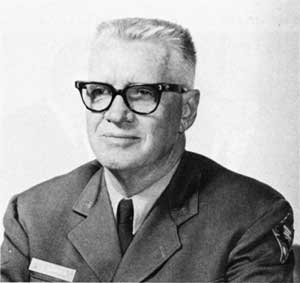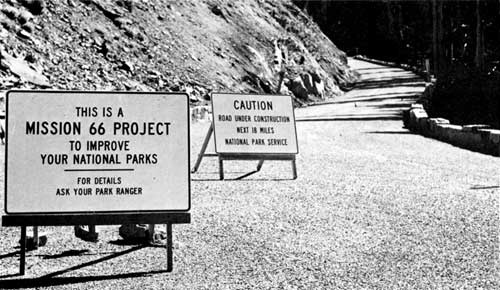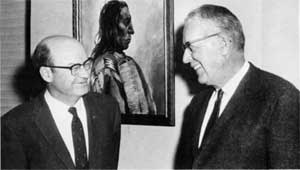![]()
Organizational Structures of the NPS 1917
to 1985
MENU
Naturalists, Rangers, & Historians
Senior Administration Officers
| Organizational
Structure of the National Park Service - 1917 to 1985 - Administrative History |
|
Organizational Structure
 Lemuel A. (Lon) Garrison, Chief, Branch of Conservation & Protection, the field rangers' Washington Office representative. |
With the September 1954 organization (see chart #23), Administration was to become a cohesive unit and Operations as a functional entity formally began (the Branch of Conservation and Protection under Lemuel Garrison was the field rangers' Washington Office representative). This organization also consolidated Mr. Vint's influence over Design & Construction with the establishment of Field Design offices and the removal of the planning, design, and construction activities from the Regional Offices.
By 1956 and with the establishment of the Mission 66 program of park renewal (a particular interest of the Director), Mr. Wirth apparently felt he needed assistance in running the organization and re-established the Associate Director's position (see chart #24). He filled it with an experienced park superintendent, Eivind T. Scoyen, who, although not appearing on previous organization charts, had been a superintendent with increasing responsibilities in park management since the 1920's. Perhaps this was the beginning of a recognition that there was a Washington Office bureaucracy and a field bureaucracy that needed to be melded together. This dichotomy exists today and each succeeding Director has struggled with an appropriate balance. In this same organization a new regional office in Philadelphia was established.

A
typical Mission 66 project in the
Pacific Northwest.
 Ronald F. Lee & John Doerr, two long term Washington Office employees. |
Although people moved in and out of Washington, there was a hard-core of continuity of Branch/Division chiefs with long term varied Headquarters experience (Thomas Vint, Design & Construction; S. Herbert Evison, Information & State Cooperation; Charles Richey, Lands; Donald Lee, Lands & Concessions; Ronald Lee, History & Operations; Herbert Kahler, History; Hillory Tolson, Administration & Operations; Frank Ahern, Safety; John Doerr, Natural History & Interpretation; and Lawrence Cook, Forestry & Ranger Activities).
The organizations of the late 1950's and early 1960's were not particularly distinctive (see charts #23 & #24). Maintenance appeared as an organizational entity as did formal recognition of the ranger role with the establishment of a Division of Ranger Activities reporting directly to the Director. The 1957 organization (see chart #25) reflects the push and pull between Washington and the Field as well as any organizational structure up to this point Administration was Administration, Design and Construction influence over the physical and projected appearance of the parks was never stronger. The Mission 66 staff through William Carnes had strong ties to earlier Design and Construction relationships, his personal relationship with Thomas Vint going back to the early 1930's. Interpretation under Ronald Lee (a historian) and Daniel Beard (an interpreter of natural history, and first superintendent of Everglades National Park) had a strong influence over the historical and eastern parks. Recreation Resources Planning, or the "planners of the future," were former staff in the CCC program under Mr. Wirth. Apparently, the creation of the Ranger Activities Division (see chart #25) reporting to the Director was clear recognition that "the uniformed ranger was entitled to a Washington Office voice." Lawrence Cook, as Division Chief, sat on the Superintendent Selection Committee of the period.
In the late 1950's the Service made an attempt to create a sixth Regional Office in St. Louis, Missouri, even to the extent of appointing a Regional Director, John S. McLaughlin. The Department, however, would not formally approve and in the words of Howard Baker, "the idea died before it was born."

The
"six" Regional Directors, L to R:
Howard Baker, Region II, Omaha, Nebraska;
Elbert Cox, Region I, Richmond, Virginia;
Lawrence Merriam, Region IV, San Francisco,
California; Minor Tillotson, Region
III, Santa Fe, New Mexico; John McLaughlin;
Daniel J. Tobin, Region V, Philadelphia,
Pennsylvania.
The December 1961 organization restructured to five Assistant Directors: Administration; Conservation, Interpretation and Use (Operations); Public Affairs; Resource Planning; and Design & Construction (see chart #26). One might note that for all the years that Thomas Vint was a major force within the Service it was not until one month before he retired in 1961 that Design & Construction was upgraded to an Assistant Directorship and was then subsequently filled by A. Clark Stratton, a manager, not a Design and Planning professional.
There were personal relationship problems with this organization; the Lands Division moved back under Operations rather than Administration and Safety moved back under Administration rather than Operations -- both for conflict reasons. Additionally, the Assistant Director, Public Affairs, was not particularly pleased with what he supervised based on his perception of his skills and talents. Resolution of this quasi-problem did not occur for four years and the subsequent reorganization.

(continued)
|
History | Links to the Past | National Park Service | Search | Contact |